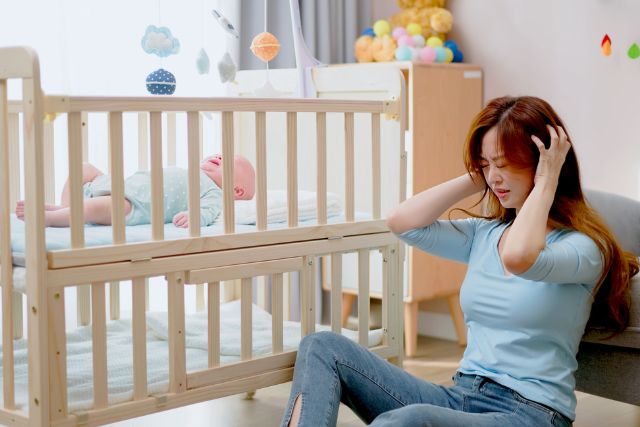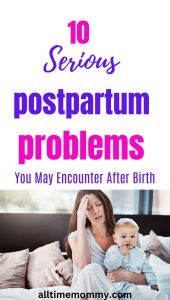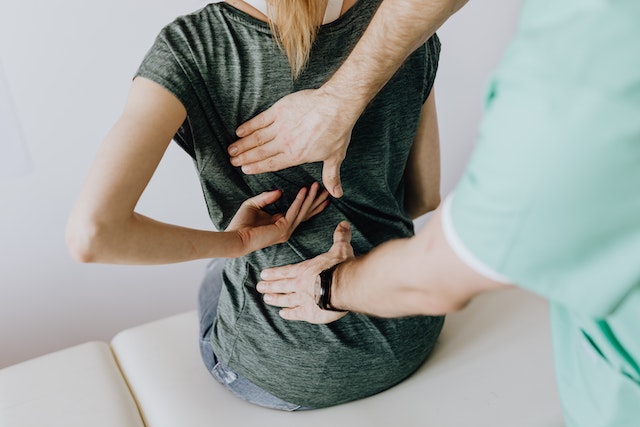Postpartum problems you may encounter after birth and how to successful deal with them
You’ve just brought life on earth, Congratulations! The feeling of joy, close medical observation, and your family care have been overwhelming. I know. You’ve been feeling like a queen, ha!
But you know what, it’s almost coming to an end.
If you are lucky, this attention may extend till the second week after delivery, and then it’s all about you, your baby, and maybe your spouse.
You may wonder, but what is the big deal. I want my private life.
Well,
The deal is not that big, only that many untold stories happen behind doors within your first six weeks after childbirth. The issues are unique, and as such most women never speak about them in public.
A recent study shows that at least 70 to 80 percent of women undergo a mild depression in the 40 days after delivery.
This depression can occur as a result of one of the postpartum problems I am about to discuss in this post.
That is why it’s essential to read on and get to know about your first six weeks after delivery.
Here we go.
Post-pregnancy General Wellness
The first six weeks are crucial for a new mom. You need to take care of your health to heal faster from pregnancy-related issues. Among the common issues that you may encounter include;
1. Postpartum Bleeding
Postpartum bleeding or lochia involves the discharge of blood, uterine tissues, and mucus after giving birth. It happens regardless of whether you had a C- section or normal delivery.
According to medics, your body is trying to return to its pre-pregnancy state. It’s doing so by getting rid of the thickened uterus lining and tissues necessary to support pregnancy.
How Long Should Postpartum Bleeding Last?
Lochia is quite heavy and lasts longer compared to normal menstruation, and it may take you 2 to 6 weeks, depending on the person.
In The first few days, say 3 days, you may experience a heavy flow with clots. You may also experience painful cramps. The color will range from dark red and may become lighter as the bleeding lessens.
After the first week, the blood color should be pinkish or brownish. The cramps will also decrease as the blood Clots get smaller and disappear. Also, the discharge should reduce significantly, and in 3 to 6 weeks, it should stop.
Why Your Postpartum Bleeding Might Increase
Under normal circumstances, your lochia should lessen within the first few weeks. And by the sixth to eighth week, it should have stopped.
But this is not usually the case, as some women have continued to bleed long after their first sixth weeks.
According to a study, you may experience prolonged lochia if you have a piece of placenta retained in the uterus. If this happens, the placenta tissues cause your uterus to remain enlarged, thus prolonged bleeding.
Its, however, advisable to do a scan in case you feel your bleeding is abnormal. By doing a scan, you may find out whether it’s an infection or anomalies that happened during childbirth.
Additionally, factors like engaging in strenuous household activities may increase bleeding after childbirth. Also, sitting for a long time and exercising too early can increase bleeding after delivery.
How to Manage Postpartum Bleeding
During postpartum bleeding, it’s advisable not to insert anything in your Yoni, including tampons. You should use heavy maxi pads, sometimes provided in hospitals. Avoid using light pads or cotton wool if your flow is heavy, as they may stain your pants.
To ease your cramps, ensure you take hot baths at least twice a day. This can be in the mornings and evenings for three days. If you had a normal birth, ensure that you have a proper uterus massage after a bath for relaxation.
Never neglect to eat food that is rich in iron for blood formation. Rest a lot and avoid doing strenuous work, especially those that exert pressure on your pelvic floor.
When Should You Worry About Postpartum Bleeding?
Although Postpartum bleeding is natural, medics warn that some symptoms that accompany the bleeding can be indicators of severe health issues. These symptoms include:
• You experience a high fever
• You have an increasingly strong, unpleasant odor from the Yoni
• Excruciating cramps
• Feeling dizzy most of the time
• Irregular heartbeat
If you witness such symptoms, visit your gynecologist for a checkup as soon as you can.
Related:
2. Postpartum Back Pains
Postpartum back pain can result from relaxin, estrogen, and progesterone hormonal changes.
During pregnancy, your body releases relaxin, which is crucial for muscle relaxation. The aim is to aid in the contraction and expansion of uterine muscles and Yoni walls in preparation for delivery.
After delivery, you may find a significant decline in these hormones. The decrease in the hormones may cause the joints and surrounding tissues to stabilize and return to the pre-pregnant state. A process that may take about 6 to 8 weeks.
This sudden decrease in relaxin and other hormonal levels may cause:
• A general feeling of tiredness
• Inability to effectively perform your duties
• Pain in the lower back and hip, especially while walking or working.
Sometimes you may also undergo bodily trauma during childbirth. The effect of the trauma may involve soft tissues, the lower back, pelvic bones, and joints, causing more pain and discomfort.
So,
How Can You Ease Postpartum Back Pain?
There are various practical tips to help you deal with postpartum back pain.
• While breastfeeding, ensure your back is upright. You may put a small pillow or cushion behind your waist to support your lower back. Also, avoid sitting at the edge of the bed or in places that do not offer back support.
• Avoid bending directly when picking items on the floor. Instead, kneel or squat, especially when washing your baby or doing tasks that require you to bend. You can consider doing some tasks like changing baby nappies on raised platforms.
• keep your back straight and bend your knees when lifting anything
• Have some good resting time to facilitate quick healing
• Take hot water baths for relaxation. You may incorporate essential oils like pure coconut oil for a better feel.
• Get someone to massage your back
Related: 7 Unwritten Baby Routines That Sustained My Sanity In The First 3 Months After Childbirth
3. Postpartum Preeclampsia
According to research, postpartum preeclampsia is a condition that may occur when your blood pressure rises significantly soon after delivery. In most cases, you will also have excess protein in your urine.
This condition can happen within 48 hours after delivery, though you may still be at risk for about six weeks after childbirth.
The most common predisposing factors include;
• Gestational hypertension or preeclampsia during pregnancy. Which, under normal circumstances, goes away after delivery
• Obesity. It may occur if you hard a Pre-pregnancy BMI >30.
• Progestational diabetes millitus
• Family history of postpartum preeclampsia
• Being a young mother under the age of 20
• Being an older woman above age 40
• Having twins or multiple babies
What are the Symptoms of Postpartum Preeclampsia?
Postpartum preeclampsia is a silent killer disease. Often one will not show any signs, especially now that you’re concentrating on recovery after childbirth.
However, when you notice any of the following signs, try to seek immediate medical attention.
• High blood pressure (hypertension) of about 140/90- can only be diagnosed through constant checkups
• Having excess protein in your urine (proteinuria). This can only be diagnosed in medical labs.
• Constant severe headaches – which may be an indication of a rise in blood pressure
• Vision changes. You may experience temporary loss of vision, blurred vision, or light sensitivity
• Pain in your upper belly
• Nausea and vomiting
• Shortness of breath
• Decreased urination
According to Cleveland Clinic, Postpartum preeclampsia can lead to brain damage, stroke, HELLP syndrome, and death if not treated.
How long does it take for postpartum preeclampsia to go away?
According to a study, patients who had suffered postpartum preeclampsia may recover within the first six weeks after childbirth. But in some circumstances, the symptoms may persist longer depending on other predisposing risk factors.
You only need to manage the condition through close monitoring and adherence to your medical prescription.
Related: 12 Ways to Prepare for Delivery in Your Final Trimester
4. Sleep and Tiredness
It is impossible to mention new moms without adding the elements of sleepless nights. Often your little champ comes with sleeping patterns that they were used to while in the womb.
They may sleep during the daytime and stay awake at night. This alters your program, and if you do not plan properly, you might find yourself without resting time.
The common sign of lack of sleep for new mothers is tiredness. You’re feeling low and without the energy to do anything. Sometimes you may develop bad tempers or back pains due to prolonged sitting. Also, you may get easily irritated with minor issues.
The perfect way to overcome this huddle is to get more sleep or rest. Here are some tips that may help you create time for resting.
Sleep when your baby sleeps
It’s easier to fit in your baby’s schedule or routine during the first six weeks after delivery than to force him into your schedule.
Try to sleep with your baby, even if it means sleeping long hours during the day. Sometimes it’s tempting to use this time to catch up with household chores, but you’ll rather have your house look crappy for a while than sacrifice your health or well-being.
Also, If your spouse is willing to help, finish up your work and get to bed early.
Look for extra help and support
One of the ways to prepare for childbirth is to mobilize support. You may have employed a nanny, or maybe you are living with a few relatives. Please don’t hesitate to seek help whenever you need it.
Also, check on your baby’s sleeping behavior. Sometimes newborns love to sleep on people’s laps, but trouble begins when you try laying them in their coats.
If this is your case,
Why don’t you engage a friend or family member to assist on this noble duty so that you can get some resting time? I mean, just holding a sleeping baby is not hard work at all.
Related: Here are 10 Super Effective Remedies for Colic In Babies
5. The Postpartum Baby Blues
Giving birth is not easy. Leave alone taking care of a newborn. The excitement of getting a baby often ends after you leave the maternal ward and realize that it’s more of “me” work and not the family job as anticipated.
That is when the baby blues sets in.
A new mother is said to have ‘baby blues’ when you experience low mood, anxiety, or mild depression.
Sometimes she may have a feeling of regret about her acquired status instead of being grateful.
“Baby blues” may occur due to sudden hormonal changes after childbirth. The main symptoms may include:
- Getting emotional to the extent that you may cry for no reason
- Being irritated by minor issues.
- Constant mood swings
- Anxiety and restlessness
These baby blues symptoms only last for a few days or a week, and with a good support system, you may be well off and ready to move on. Here are a few suggestions to get you moving;
• Accept your new status: the only way to accept your new status is to work on your mind. Girl, this hard work does not last forever, and soon, you may be surprised how your little champ quickly grows into an amazing adult by the grace of God. Give your best when you have a chance and learn to let go of whatever you can’t control.
• Spend time with others: Your family and friend can come in handy on your way to overcoming baby blues. Open up about your feelings and allow them to give you their views. Listening to other people’s stories can help elevate your moods, especially if you can relate to your current situation. If you do not have friends, you may consider social media engagements or invite your health therapist for a candid talk.
• Learn to Unwind: Spend some time, probably in the evening, doing something you enjoy. It may be journaling, reading storybooks, coloring, or watching movies. Unwinding helps you to empty your mind and foster relaxation by eliminating worries.
• Learn to accept help from well-wishers.
• Just sleep.
Related: Here is How You Can Take Care Of Your Baby’s Belly Button After Birth
6. Postpartum Depression
Postpartum depression is a mental health problem that affects women after birth. It is a persistent feeling of worthless, sadness, and loss of interest in your daily activities.
According to a study, postnatal depression affects 1 in 10 women. And It may occur between the second and eighth week after delivery.
A recent study shows that a woman may get postpartum depression due to emotional turmoils during pregnancy. These negative emotions can result from losing a loved one, divorce, or financial stress. Other factors may include hormonal imbalances or hereditary factors.
The most common postnatal depression symptoms include;
• Loss of interest in the baby.
• Feelings of hopelessness and worthlessness
• Not being able to control your emotions
• You may experience panic attacks and leave in illusions
• Feeling extreme tiredness but unable to sleep
• Not being able to enjoy life
• Sometimes you may experience memory loss
• Loss of appetite
• Feeling unwell, with body pains
Getting help for postnatal depression
Postpartum depression is a disorder that can rake someone’s life. You do not need to pretend that everything is fine when it’s not. Always remember that this is a disorder and not a sign that you dislike your child or motherhood.
Try talking to someone you trust. It can be your husband, family member, or friend. Also, reach out to health therapists for counseling.
Treatment for Postnatal Depression
In minor cases, you may treat postnatal depression with counseling. Your health care provider can give this therapy at home or in a health facility.
If your case is severe, the doctor may prescribe antidepressants. Always inform your doctor about your health history and breastfeeding status. The information may help determine the type of medication you will be given since you do not want to interfere with the breast milk.
7. Postnatal Stitches
What is a perineal tear?
The perineum area is found around the Yoni opening. In most cases, this area can tear as it stretches during the baby’s birth.
Consequently, your midwife may voluntarily cut the perineum to increase space for your baby to be born, which is referred to as episiotomy.
After delivery, you will be stitched and left to nurse your postnatal wound at home.
How long does a stitch take to heal after birth?
Postnatal stitches can take 1 to 3 weeks to heal. It all depends on the degree of tear and how well you clean the wound.
When you start healing, you may notice pieces of the stitches in your sitz water basin. Sometimes the place may become itchy, but that does not mean you should scratch yourself, as that can delay the healing.
Make sure to visit your health care provider if you experience any of the following:
your stitches become painful and smelly
- It’s past 6 weeks, but your wound does not heal
- you are having problems controlling your bowels
- you pass poo through your Yoni
- you have a fever
Related:
11 Effective Ways to Take Care of Your Yoni After Birth
8. Postpartum Incontinence
Postpartum incontinence is when a new mother may have trouble holding in her pee or wind. In a worse situation, you might even have cases where you soil yourself with poo.
The leakage usually comes out when you cough, sit for long hours, do strenuous work, or try to hold urine for some time.
Additionally, during your first six weeks after delivery, you may also get a heavy feeling between your Yoni and the poo area. In this case, you may feel as if the colonies or other internal organs close to the anus are pushing outwards.
Do not panic.
These feelings are normal, especially if you had a normal delivery. And the condition can slowly improve as your body heals and returns to normalcy.
In case you have a leaky bladder or incontinence, you may need to do a few sessions of pelvic floor exercises to strengthen the muscles between the bladder and anus.
If you are experiencing severe incontinence, ensure that you go for a medical checkup, as this can be a sign of severe bladder damage.
9. Making Love After Childbirth
This is one of the lessons no one will teach you.
Even though you may never come across written rules about when to start making love after childbirth, you must assess your physical and mental health before agreeing on it. Otherwise, this one-night thing can send you back into your early postnatal days, yet you may have made significant milestones in healing.
Some of the factors to consider before indulging in bedroom matters is whether you had perianal tears or your stitches have fully healed. Examine whether you have soreness in your Yoni since having to make love in that condition will probably hurt you and delay your healing.
Additionally, it’s good to note that hormonal changes after birth can make your Yoni feel drier than usual. It is thus important to give yourself some time before going back to sex.
The best approach to making love after delivery is to discuss it as a couple. Let everyone air their concerns, and in case of any worries, do not hesitate to speak with your professional health provider or marriage therapist for counseling.
Related: Here is Mommy Friendly Tips for Safer Sex After Childbirth
10. Contraception After Childbirth
Contraceptives or postpartum birth control methods are subjects you don’t want to turn a blind eye to lest you plan to have another baby soon.
How soon can you get pregnant after giving birth?
Biologically, ovulation occurs about two weeks before the onset of your menses. This is to say it’s possible to get pregnant before you have your first postpartum period.
And this can occur as early as four weeks after giving birth. It all depends on individual biological makings and whether you’re breastfeeding exclusively or not.
Studies have shown that exclusive breastfeeding can act as a natural contraceptive. Medics refer to this birth control method as the lactational amenorrhoea method or LAM. For you to successfully rely on LAM, you need to fulfill the following conditions ;
You are on exclusive and frequent breastfeeding, you have not started seeing your periods, and the time between feeding is not more than 4hrs during the day or six hours at night.
These conditions can sometimes be impractical and challenging to fulfill due to other commitments. And that is why it’s essential to start using another form of contraception if:
• You are feeding them alongside breast milk
• The lochia has stopped, or you have already experienced your first period
• Your breastfeeding intervals are longer than four hours during the day
• Your breastfeeding intervals are longer than six hours during the night
• You’re sexually active
Using contraceptives helps you avoid unintended pregnancy and gives liberty to plan how you want to space your children.
Research from the American College of Obstetricians shows that the best time to choose the birth control method you will use after childbirth is while you are still pregnant. And in so doing you may consider the following factors;
• Timing— Ask your doctor whether the method you choose is safe for use right after childbirth. This is because you may need to wait for a few weeks before using Some contraceptives
• Breastfeeding—Be sure to inquire whether your preferred method can interfere with your breast milk supply.
• Effectiveness—discuss the effectiveness of whichever contraceptive method you may choose with your gynecologist.
Takeaway
Even though these common health issues can be like a thorn in the flesh when you’re trying to heal after delivery, always take heart for nothing last forever. Make your health care provider your best friend. Eat well, take care of your self and never forget that your first six weeks after delivery is crucial for your physical health and mental stability.
I am looking forward to hearing from you in the comments below and maybe sharing this post in case you found it valuable.
Up next:
- A Quick Look Into Your Baby’s Developmental Milestone(0-12months) and How To Speed Up Their Growth
- Postpartum Fatigue; 15 Home Remedies to Help You Beat Postpartum Fatigue and Dizziness
- 10 Most Important Pregnancy Nutrients for a Wholesome Baby Development
- 13 Worrisome Things To Avoid For Better Baby Development
DISCLAIMER The information contained in this post is for general information purposes only. I’m not a health practitioner and as such, this information should not be used as a substitute for consultation with your professional service provider.





